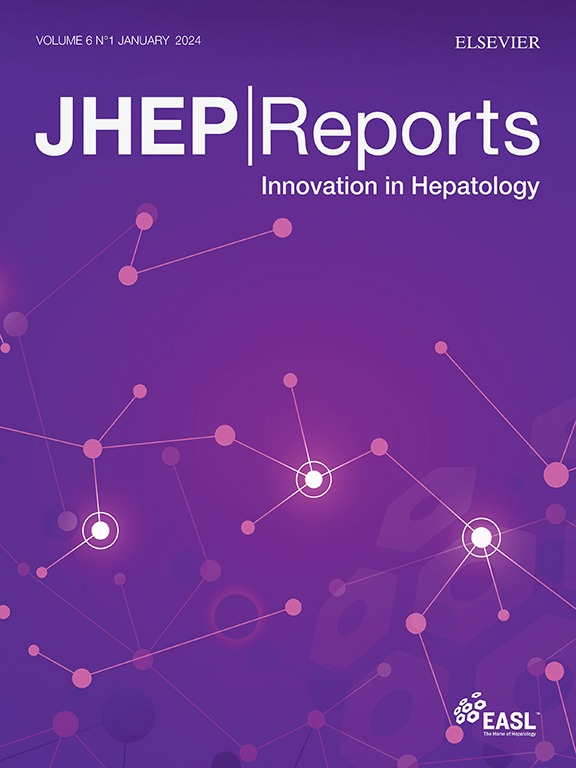Primary sclerosing cholangitis–inflammatory bowel disease: Epidemiology, mortality, and impact of diagnostic sequence
IF 9.5
1区 医学
Q1 GASTROENTEROLOGY & HEPATOLOGY
引用次数: 0
Abstract
Background & Aims
Primary sclerosing cholangitis (PSC) carries significant morbidity and mortality compared with inflammatory bowel disease (IBD). We characterized epidemiology trends and outcomes in those with PSC-IBD and IBD, paying particular attention to the impact of PSC-IBD diagnostic sequence on outcomes.
Methods
Incidence and prevalence of PSC-IBD and IBD (2002–2018) were evaluated using validated health administrative data-derived cohorts from Ontario, Canada (population ∼15 million). Transplant and death outcomes were assessed, with PSC-IBD diagnostic sequence as the exposure of interest.
Results
Incidence of PSC-IBD and IBD was 0.46 and 24.6/100,000 person-years (PYs) respectively, whereas prevalence was 5.53 and 588/100,000 PY respectively. Incidence/prevalence of PSC-IBD increased over time, unlike for IBD. Age at IBD diagnosis was earlier among those with PSC-IBD compared with those with IBD alone. Higher socioeconomic status associated with high PSC-IBD incidence rates and fastest incidence rise. Those diagnosed with IBD before PSC had higher risk of transplant/death compared with PSC before IBD (hazard ratio [HR] 1.34, 95% CI 1.02–1.75), driven by an increased risk of death (HR 2.73, 95% CI 1.68–4.45). PSC-IBD had a 4.5-fold greater risk of transplant/death compared with IBD alone. Liver-related and luminal gastrointestinal disease, particularly hepatopancreatobiliary malignancy, were predominant causes of death among those with PSC-IBD, while cardiovascular and respiratory diseases were predominant among those with IBD.
Conclusions
Population-level data support distinct epidemiological patterns among people living with PSC-IBD compared with IBD, including a higher socioeconomic status and worse outcomes in those found to have IBD before PSC.
Impact and implications:
Individuals with primary sclerosing cholangitis (PSC) face increased morbidity and mortality compared with the general population and those with inflammatory bowel disease (IBD); yet, most individuals with PSC are found to have concomitant IBD during their lifetime. This study describes the distinctive epidemiological differences and mortality trends at the population level between PSC-IBD and IBD. While PSC-IBD remains a rare condition, diagnoses are on the rise (particularly among higher socioeconomic status populations), with most patients being diagnosed with IBD before PSC; this group also experienced higher mortality post-PSC diagnosis compared with those diagnosed with PSC first, with a large proportion of deaths caused by liver- and gut-related causes. Practical applications of these findings include further studies to evaluate whether earlier identification of PSC-IBD affects disease outcomes, as well as educating patients, clinicians, and policymakers on the importance of recognizing PSC-IBD as a distinct entity from IBD alone.

求助全文
约1分钟内获得全文
求助全文
来源期刊

JHEP Reports
GASTROENTEROLOGY & HEPATOLOGY-
CiteScore
12.40
自引率
2.40%
发文量
161
审稿时长
36 days
期刊介绍:
JHEP Reports is an open access journal that is affiliated with the European Association for the Study of the Liver (EASL). It serves as a companion journal to the highly respected Journal of Hepatology.
The primary objective of JHEP Reports is to publish original papers and reviews that contribute to the advancement of knowledge in the field of liver diseases. The journal covers a wide range of topics, including basic, translational, and clinical research. It also focuses on global issues in hepatology, with particular emphasis on areas such as clinical trials, novel diagnostics, precision medicine and therapeutics, cancer research, cellular and molecular studies, artificial intelligence, microbiome research, epidemiology, and cutting-edge technologies.
In summary, JHEP Reports is dedicated to promoting scientific discoveries and innovations in liver diseases through the publication of high-quality research papers and reviews covering various aspects of hepatology.
 求助内容:
求助内容: 应助结果提醒方式:
应助结果提醒方式:


